 Virtuosity and Performance
Mastery issue, 2003/04
Virtuosity and Performance
Mastery issue, 2003/04
Who Knows - and Who Cares (about performance mastery)?
Copyright © Susan Melrose 2003.
(No part of this text may be reproduced without the written permission of the author.)
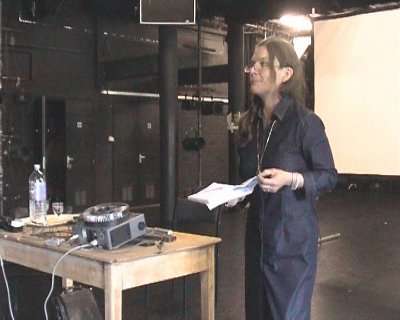
This material was presented live at the Virtuosity and Performance Mastery symposium for postgraduate/research degree students and academic staff over two days by Performing Arts at Middlesex University on 31st May and 1st June 2003.
I have become increasingly aware, since the time when I researched my own doctorate, that the "training in theory" that I received provided me with few mechanisms enabling me to engage either with performance-making processes, or with performance excellence, or even with the aspiration to performance excellence. Indeed, I was trained in strategies which located me fair and square in the performance audience - from where I could do no more than thematise performance product as other, engaging thereafter in the pecularities of spectator studies. I had at my disposal, as was common at the time, not only the tools but the aspirations specific to what has been called the "textual turn", which, according to the art critical writer, Hal Foster, (1) "refashioned much art and criticism on the model of the text" in the late 1960s and 1970s. It was on the basis of the widespread promotion of the power of the textual turn that many of us in the university promoted, to paraphrase Peter Osborne's words (2), the 'semiological rearticulation' of heterogeneous cultural practices. This sort of "critical-theoretical" project, Ulmer has pointed out, (3) was informed by a "hermeneutics of suspicion", directed at dominant institutions and their institutionalised power structures, and it tended to perpetuate, again according to Foster (4) the "secret continuation of modernism by other means" (Foster 1996:xiv).
We can find in any number of millennial texts this kind of revisioning of the recent past which identifies, some thirty years after these events, some but not all of the historical bases for the wide uptake, in the 1960s and 1970s in critical and cultural studies in the European and English-language university, of a "textual turn" which, purportedly "Saussurean", reproduced across cultural studies not only the "model of the text" but the modes of decipherment and "rearticulation" which the model of the text seems to allow.
Some of the translated terms and modes of writing-production linked to the textual turn, which derived from but repositioned elements of the late 19thC Saussurean linguistic model, have been assimilated into everyday discourse registers used in places like this one, where they play a commonsensical rather than expert or technical role. (Their impact can be identified wherever talk is of "reading" the stage, of signifiers and signifieds, of the "text or discourse of the mise en scene. They continue to play both a technical and an aspirational role in the recent writing of some musicologists and some "performance theorists" - but I don't intend to give too much time today to what might be viewed on occasion as an epistemological muddle. What is more interesting, at least from my own perspective, is that the textual turn has been followed, rather more recently, by what has been called the "practice turn in contemporary theory".
"Practice theory" is not simply a philosophical turn, enabling professional philosophers (Osborne 2001) to enquire into the ways in which, as one writer has put it, (5)"practices serve as conditions for the possibility of various kinds of complicated human comportments" (C. Spinosa 2001) although it is also this. Nor is "practice theory" a unified field of writing, although, once again, it is a field of writing. In the same account Spinosa notes of "practice" that it might serve as (6) "the appropriate notion for upsetting the [ancient] philosophical opposition between theory and practice" (201). In more general terms, if we were to replicate Foster's observations on the textual turn, we might simply want to suggest that recently 'much art and criticism has recently been refashioned, in certain contexts, on the model of practice'.
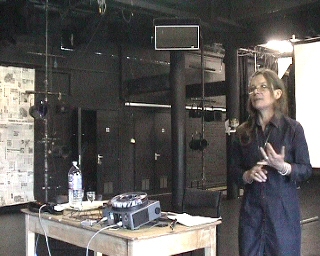 I do hope that warning bells have
sounded, in the past few moments, for those of you who are or have some claim to be
professional or expert art-practitioners: once philosophers - or should I say professional
writers and educators, for such is the lot of many a professional philosopher - once
philosophers have taken "practice" over in writing, you may well feel that you will
never get her back. Certainly the debate and counterdebates represented under the
written heading of "practice theory" can be dispiriting - except
at that moment or those moments when something you sense in your
own reading of practice-writing - and I use the verb "sense" advisedly -
resonates for you with something you retain from expert mixed-mode
practices. I have referred to processes of sensing and resonating; at this
point I want to add the notion of a moment of recognition, when something you sense, in
reading practice-writing, seems to achieve for you a degree of empirical fit
(7) with your own experience of complex
arts-expert practices.
I do hope that warning bells have
sounded, in the past few moments, for those of you who are or have some claim to be
professional or expert art-practitioners: once philosophers - or should I say professional
writers and educators, for such is the lot of many a professional philosopher - once
philosophers have taken "practice" over in writing, you may well feel that you will
never get her back. Certainly the debate and counterdebates represented under the
written heading of "practice theory" can be dispiriting - except
at that moment or those moments when something you sense in your
own reading of practice-writing - and I use the verb "sense" advisedly -
resonates for you with something you retain from expert mixed-mode
practices. I have referred to processes of sensing and resonating; at this
point I want to add the notion of a moment of recognition, when something you sense, in
reading practice-writing, seems to achieve for you a degree of empirical fit
(7) with your own experience of complex
arts-expert practices.
I have used terms in these last sentences which are hesitant, constitutively imprecise, and personalised, stressing your sensing, your experience, for the simple reason that I am supposing that these modalities might better account for the processes of research more generally, than do terms like "central hypothesis", argumentational structure and propositional logic, which describe a later stage in research-writing. I want in addition to suggest here that "sensing", "resonance" and "recognition of empirical fit", operating through a multi-dimensional schematics or pattern-recognition, for someone, might more generally better account for research in the arts, than does more conventional research-methodological enquiry pursued in many instances of conventional literature-based research.
But as an initial account of research practices, these modalities don't go far enough when concern is with expert arts-practices as research. To take them further, I want to add an observation from the philosopher and practice-theoretician Karin Knorr Cetina, with regard to what she calls "epistemic practices" or "knowledge practices". Research practices, in Knorr Cetina's terms, particularly where these practices are creative and constructive, are characterised by (8) "an interlocking structure or chain of wantings"; by a relational idiom - which "can also carry the reflexive and affective aspects of epistemic [or knowledge-] practice", and by a constitutive lack of completeness, since it is only "incomplete objects [that] pose further questions". More delicately, perhaps, Knorr Cetina describes epistemic practices and objects as characterised by "their nonidentity with themselves" (176). Non-identity with themselves, in Knorr Cetina's account, emerges from her observation that research representations "never quite catch up with the empirical object; they always in some aspects fail (misrepresent) the thing that they articulate", even though they tend "to imply what is still missing in the picture"(185).
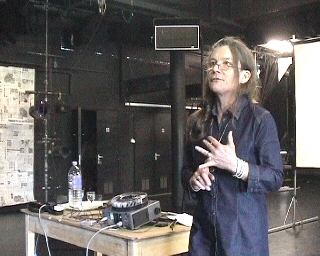 With regard to "practice
theory" more generally, Knorr Cetina is keen to point out that whereas many (9) "current conceptions of practice emphasise
the habitual and rule-governed features of practice", creative and constructive research
practices are characterised by the expert practitioner's ability to keep learning,
(10) "to develop the knowledge base
[of the practice concerned, through] continually reinvent[ing] their own practices of
acquiring knowledge" (Knorr Cetina 2001).
With regard to "practice
theory" more generally, Knorr Cetina is keen to point out that whereas many (9) "current conceptions of practice emphasise
the habitual and rule-governed features of practice", creative and constructive research
practices are characterised by the expert practitioner's ability to keep learning,
(10) "to develop the knowledge base
[of the practice concerned, through] continually reinvent[ing] their own practices of
acquiring knowledge" (Knorr Cetina 2001).
Her position here would appear to contrast sharply with that of many other practice theorists, whose accounts tend to generalise (11) - "[S]ocial practices govern both the meanings of arranged entities and the actions that bring arrangements about: this governance is the basis of social order"- and, to focus, in much of one particular collection of essays, not on creative and constructive research practices, but on the (12) "diverse disciplines [of] philosophy, cultural theory,...history, ...sociology, anthropology, science and technology". In these terms, practice theorists contend that "practices ...underlie subjects and objects, highlight nonpropositional knowledge, and illuminate the conditions of intelligibility". They would thus be "genuine collective entities, immune to individualistic analysis", "collective possessions and accomplishments sustained through interaction and mutual adjustment among people."
Knorr Cetina's contrasting position emerges both from late 19thC pragmatics, which provides her in part with the "relational idiom" according to which research practices are carried out by someone, somewhere, to some complex end or ends, and with that "interlocking chain of wantings" I quoted earlier in mind. Her position would seem to emerge from an attempt to account both for research processes - always driven, and always incomplete - and the relationship between those processes and the ways in which epistemic or knowledge objects and practices might be viewed and understood. To pursue the latter aspiration, Knorr Cetina draws on Heideggerian philosophical writing - particularly his writing on technology and epistemology - and in so doing draws her enquiry into close proximity with that of C.Spinosa, whom I have briefly quoted earlier. I shall return in a few moments to Spinosa's account of later 20thC theoretical tendencies and the models of intelligibility with which they can be identified.
First, however, I want to stress that Knorr Cetina's account of epistemic practices has the great advantage which is that she is explicitly concerned not with everyday practices, nor with avant-garde art practices, but with what she terms "the conduct of expertise" in a knowledge society, within which the experiential is taken into account in terms of "an arousal of the processing capacities and sensitivites of the person". She goes further in her distancing of her own account from those concerned with "habitual and rule-governed features of practice", by identifying (13) "nonroutine procedures" as her focus, adding to this her concern with a "characterization of practice [which is] dynamic", and within which (14) "the definition of things, the consciousness of problems...is deliberately looped through objects and the reaction granted to them", thereby also creating a fluctuating pattern of personal affective investment, excitement, and "a dissociation between self and work object".
It is this intermittent dissocation and practice-auto-reflection that permits the personalised and affective research engagement also to include and to be conditioned by a degree of distanced thematisation and "object-ivity".
What I have been particularly interested to note is her suggestion that this fluctuating pattern of investment, excitement and dissocation (15) "inserts moments of interruption and reflection into the performance of research". It is on the basis of these moments of interruption that Knorr Cetina comes to identify epistemic research practices firstly in Heideggerian terms as an unfolding, within the discipline, of 'new' aspects of the "object or practice", misrecognised, in the short term, as the research 'thing' itself, rather than as the momentary material crystalisation of the research-constitutive "wanting" (16). "Epistemic practices", she adds (17) are dynamic, newly articulative; they "are always in the process of being materially defined, they continually acquire new properties and change the ones they have" (181).
Secondly she seems to identify epistemic research practices in terms of what Spinosa identifies as a Derridian "dispersive" perspective, where a small interruption in the smooth unfolding of an aspect of the practice causes a lateral "branching off" in other directions. I shall have something more to say about what follows angular branchings off in a moment. First however I want to show you what I take to be an epistemic practice 'despite itself', which is forged within a disciplinary field, in whose terms it is unfolded, but which also incorporates both a looping-back, a degree of auto-reflection, and a series of little interruptions. The "arts-professional" research object, in this case, comes from the dance mainstream.
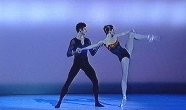
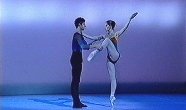
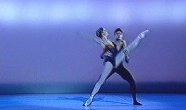
Frames from Tryst (18)
I want to turn back at this point to Spinosa's account of dispersive elaboration of practices, which he contrasts with their articulative elaboration, asking as I do so that you attempt to retain these examples of mainstream dance and recorded song and music, in terms of the expert unfolding of a core disciplinary practice, which is also characterised by a degree of looping back, little interruptions, lateral or angular branchings-off, and the possibility - at least - of dispersal. I shall want to include, in this final section, reference to one aspect in particular of Schatzki's own "practice theory", in which he attempts to account for certain practices as teleoaffective (19) and to a practice-rhetorical device - hypotyposis (20) - which I shall argue is constitutive of the relational aspect of expert creative practices, and hence to what I shall call the economies of expert creative epistemic practices.
Spinosa's suggestion, to which I return here, was that "practices" enable specific sorts of human actions, and not vice versa (21) Spinosa, in identifying different modes of development of practices - that is, "dispersion and articulation" - attempts to (22) "open consideration of general tendencies in the way practices work" to govern intelligibility. His general premise, which recalls Knorr Cetina on creative research, seems to have startled philosophers, but might well be banal to expert arts practitioners: that is, that (23) "so long as we engage in [a] practice", including an expert practice, "we will develop ways of dealing with the wide variety of things that the practice itself opens up to us" (200). It is through engagement in the practice, provided we have the required skill, Spinosa goes on, that (24) "we become better at it in ways that go beyond those we explicitly work[...] at improving". It is on this basis that Spinosa concludes that practices have a degree of autonomy of practitioners, and (25) "tend toward their own elaboration" through a user's engagement in them, "regardless of [the user's] explicit intentions".
This tendency toward autonomous elaboration, in complex practice, according to Spinosa, has "exercised a relatively small number of philosophers", but amongst them are two accounts of the elaboration of practice: a Derridian account and a Heideggerian account.
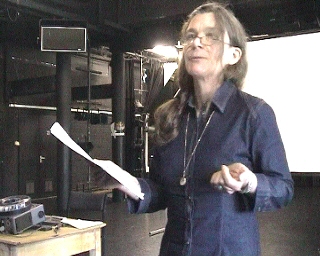 The Derridian account of the
development of practice - which Spinosa explicitly links to arts-creative expert practices,
and which we can appraise in terms of the 20thC avant-garde - (26) operates via rupture, the radical break, followed by that
degree of dispersal and dissemination that requires of the arts-practitioner an
art-determining imposition.
The Derridian account of the
development of practice - which Spinosa explicitly links to arts-creative expert practices,
and which we can appraise in terms of the 20thC avant-garde - (26) operates via rupture, the radical break, followed by that
degree of dispersal and dissemination that requires of the arts-practitioner an
art-determining imposition.
In the Derridian tradition, this radical break, dispersal of energies, and imposition, occurs because of the constitutive instability of all situations in which art practices occur. The Heideggerian account argues instead (27) for the elaboration of practices through the further articulation of the core practice.
"In developing the Derridian and Heideggerian arguments", Spinosa adds (28), we shall see that an account of the nature of elaboration determines whether the stability of things is some sort of imposition that runs against the nature of practice or is a regular tendency of practice.
Spinosa will conclude that in order to understand how (expert) practices develop through use, we need a basic Heideggerian account - concerned with the further development of the core - within which to embed a Derridian account of that discontinuity, rupture and imposition of difference, which seems to me to resonate so strongly with the working practices of some expert practitioners in live art.
Where Knorr Cetina argued that the researcher's participation in research practices is relationally and affectively "undergirded" such that her or his engagement in them oscillates between emotional investment and dissociation, subject and object positions in their regard, Charles Spinosa notes that (29) affectivity and the relational are "implicit in the [disciplinary] practice" itself, to such an extent that affective binding-in, dissociation and thematisation, and the relationality of disciplinary research practices constitute one aspect "of the general conditions of satisfaction" of the practice.
The two writers thereby seem to me to be touching on the possibility of a "disciplinary mastery" and of "affectivity and relationality", which are specific to the notion of disciplinarity itself. Schatzki identifies this quality of disciplinary practice "teleoaffective". I have been intrigued to discover that this notion of a teleoaffectivity specific to expert and disciplinary practice "itself" resonates for me with and achieves a degree of empirical fit with, my own experiences over the years of arts-disciplinary practices. I have been intrigued to note among a number of expert arts-practitioners the assertion of a certain "un-knowing" of the expert-practitioner, which I should prefer to call "disciplined un-knowing".
Hand-in-hand with this professed disciplinary unknowing go attentiveness to factors in the contingent register, and a professional attentiveness to professional or disciplinary intuitions. I want to conclude here with this notion of professional intuition, precisely because the practice theoreticians whom I have read tend to avoid the matter of intuition, or to conflate it with intuitive operations in everyday life.
I am going to go so far, here, as to suggest that it can be argued that arts-disciplinary practice itself may carry with it the possibility of an affective charge, into which the work of both expert practitioner and spectator or listener are "fitted". In this case, where singular practitioners weave their work into disciplinary convention reviewed in terms of changing situations, it should be wholly possible for us to claim that the disciplinary arts practitioner, expert in a knowledge-economy, does more, constitutively, than she knows. Secondly that, through the operations of hypotyposis, she will genuinely be able to do more, in terms of the spectator or listener's own engagement, than she does.
It is the Heideggerian account of the development of practice through further articulation of the core, within which we may or may not choose to embed the Derridian or dispersive account, which enables me to deal with this "knowledge-situation". The expert practitioner's signature, in this account of epistemic (or research) practices is insinuated into the spaces which intermittently open between the autonomous disciplinary practices and her or his own engagement with these.
If arts-practices, in the hands of the expert-practitioner, "tend toward their own elaboration" in a given disciplinary field, such as we have seen in this televisual account of Wheeldon's work with Darcey Bussell and Jonathon Cope for the Royal Ballet, then we are beginning to touch on the notion that knowledge-systems are at work, within the given expert practice, to such an extent that the practice can seem to do more than it does. In other words, the disciplinary systems themselves, once sufficent performative indicators have been triggered by actual choices 'in the work', will seem, for a given spectator, to expand and fold around those choices. They thereby transmit, to an expert spectator, a greater 'knowledge-body' than needs to be articulated as such by the given practitioners. As soon as a commentator notes that a piece 'works on many levels' (a curious hierarchising spatial metaphor), we find ourselves in the domain of the expert-creative 'more than they know'.
To the extent that the expert practitioner fits her or his work into the disciplinary framework, in other words, he or she can seem to do more, in practice, than she or he does, and to "know more" than he or she knows. It is the Heideggerian account of the development of practice through further articulation of the core, and not the Derridian account, which enables us to deal with this "knowledge-situation".
The expert practitioner's signature, in this account of epistemic (or research) practices is insinuated into the spaces which intermittently open between the autonomous disciplinary practices and her or his own engagement with these. In the case of Tryst, "signed by" Wheeldon and Bussell, I would argue that we can see moments of "dissociation between self and work object", which occurs when "the definition of [somatic 'objects', and] the consciousness of problems...is deliberately looped back through objects and the reaction granted by them".
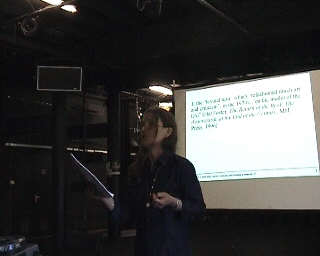 This sort of looping back, which we
can see as compositional choices in Tryst, produces moments of interruption and
reflection within the knowledge practice, as soon as we identify, as I do from the basis of
limited experience, elements of a classical vocabulary reworked into a recognisably
"contemporary dance" framework, which in the piece is shown in a process of
unfolding the core vocabularly and ostending it. But I would also argue that it is possible
here to observe the choreographer's signature-'look', as it moves between present
object and disciplinary core, in the expert practice. And further that we can also see, and
need the notion of, rule-governed and teleogically-determined choices which reflect back to
the established codes and conventions of genre and discipline. Schatzki identifies these
elements in terms of "teleoaffectivity".
This sort of looping back, which we
can see as compositional choices in Tryst, produces moments of interruption and
reflection within the knowledge practice, as soon as we identify, as I do from the basis of
limited experience, elements of a classical vocabulary reworked into a recognisably
"contemporary dance" framework, which in the piece is shown in a process of
unfolding the core vocabularly and ostending it. But I would also argue that it is possible
here to observe the choreographer's signature-'look', as it moves between present
object and disciplinary core, in the expert practice. And further that we can also see, and
need the notion of, rule-governed and teleogically-determined choices which reflect back to
the established codes and conventions of genre and discipline. Schatzki identifies these
elements in terms of "teleoaffectivity".
Schatzki is interested in what he calls "practice mind-ed orders" - that is, the concept of mind, in relation to practice, and the role of "mind" in structuring practices as social order. By the term "teleoaffectivity", he signals the notion that complex practices can be determined, in part, with or without the practitioner's explicit intention, by their functional orientation to triggering an affective outome in the spectator or listener. Noting that "practical sensibility", in an expert practitioner, may function perfectly well without the need or indeed the potential, in that practitioner, for explanation of the practice undertaken, Schatzki suggests that "[p]ractical intelligibility ... is primarily determined not by understanding, but by rules, teleology, and affectivity".
That is, if we transfer this account to creative disciplinary practices, expert practice is also determined in significant part by an engagement with established codes and conventions specific to the discipline; by attention to outcome - which is, in my account, always a driving force in expert epistemic practice organised by a relational idiom; and by attention to the potential for emotional engagement in the spectator or listener.
I am going to conclude here by arguing, along the lines set out by Spinosa, that the teleoaffective potential of a performance discipline may be inherent to that discipline itself, by which I mean - if we return to the notion that a practitioner does more than she does, and does more than she knows - that the expert practitioner locks into, but may also shift out from, and loop back through, the objectual status of aspects of disciplinary production as site of epistemic practice. Whatever the case with regard to judgements of taste and value, in the example of the work of Darcey Bussel and Jonathan Cope which I have cited here, I am arguing that the disciplinary core is teleoaffective, and works through the rhetoric of hypotyposis, and secondly that expert practitioners able to work professionally in the field, engage in teleoaffectivity, play with it, and re-present it in new situations, to new effects.
Notes
1. the "textual turn" which "refashioned much art and criticism", in the 1970s, "on the model of the text" (Hal Foster, The Return of the Real: The Avant-garde at the End of the Century, MIT Press, 1996)
2. the "semiological rearticulation" of heterogeneous cultural practices, (Peter Osborne, Philosophy in Cultural Theory, Routledge 2000)
3. the "hermeneutics of suspicion" (G. Ulmer, Teletheory: Grammatology in the Age of Video, Routledge 1989)
4. the "secret continuation of modernism by other means" (Foster, ibid, xiv).
5. "practices serve as conditions for the possibility of various kinds of complicated human comportments" (C. Spinosa 2001)
6. "practice" might serve as "the appropriate notion for upsetting the [ancient] philosophical opposition between theory and practice" (201)
7. "empirical fit", (G. Ulmer, Teletheory: Grammatology in the Age of Video, Routledge 1989)
8. "epistemic practices" or "knowledge practices".
Creative and constructive research practices, are characterised by
i) "an interlocking structure or chain of wantings";
ii) by a relational idiom - which "can also carry the reflexive and affective aspects of epistemic [or knowledge-] practice", and
iii) by a constitutive lack of completeness, since it is only "incomplete objects [that] pose further questions" (Knorr Cetina 2001), and
iv) by "their nonidentity with themselves" (176)
9. many "current conceptions of practice emphasise the habitual and rule-governed features of practice", rather than the particularities of 'driven' research.
10."creative and constructive research practices are characterised by the expert practitioner's ability to keep learning, "to develop the knowledge base [of the practice concerned, through] continually reinvent[ing] their own practices of acquiring knowledge" (Knorr Cetina in T. Schatzki et al (eds) 2001).
11. "[S]ocial practices govern both the meanings of arranged entities and the actions that bring arrangements about: this governance is the basis of social order"
12. "Practice theorists", according to Schatzki tend to "contend that practices ...underlie subjects and objects, highlight nonpropositional knowledge, and illuminate the conditions of intelligibility" in diverse disciplines "from philosophy, cultural theory,...history, ...sociology, anthropology, science and technology".
Practices here lose their relational and pragmatic idiom, and would thus beviewed as "genuine collective entities, immune to individualistic analysis", "collective possessions and accomplishments sustained through interaction and mutual adjustment among people."
T. Schatzki (The Practice Turn in Contemporary Theory, Routledge 2001)
13. Knorr Cetina's concern with "the conduct of expertise" begins with enquiry into "nonroutine procedures".
14. It takes on a "characterization of practice [which is] dynamic", and within which "the definition of things, the consciousness of problems...is deliberately looped through objects and the reaction granted to them", creating a fluctuating pattern of personal affective investment, excitement, and intermittent "dissociation between self and work object".
15. This epistemic-practice is characterised by a fluctuation between the personalised and the dissociated. It "inserts moments of interruption and reflection into the performance of research".
16. "what we encounter in the research process are representations or stand-ins for a more basic lack of object" (181)
17. "epistemic [practices] are always in the process of being materially defined, they continually acquire new properties and change the ones they have" (181)
18. Tryst
Dancers: Darcey Bussell and Jonathan Cope
(Royal Opera House)
Choreography: Christopher Wheeldon
Music © James Macmillan 1990, performed by the Scottish Chamber Orchestra
Video production copyright © ARTE 2002
Broadcast on BBC4, 2003
19. Schatzki: "teleoaffectivity". Practices driven by the objective of emotional engagement in the spectator or listener
20. hypotyposis is explained, in Paul de Man, in terms of a figuration "which makes present, to the senses, something which is out of their reach, not just because it does not happen to be there but because it consists, in whole or in part, of elements too abstract for sensory representation" (in On Metaphor, ed. Sheldon Sacks, University of Chicago Press, 1979).
21. Spinosa: "practices serve as conditions for the possibility of various kinds of complicated human comportments"
22. Identifying these two modes of elaboration will "open consideration of general tendencies in the way practices work" to govern intelligibility.
23. "so long as we engage in [a] practice", "we will develop ways of dealing with the wide variety of things that the practice itself opens up to us" "...[W]e become better at it in ways that go beyond those we explicitly work[...] at improving".
24. Practices therefore have a degree of autonomy regardless of the intentions of practitioners
25. "practices tend toward their own elaboration" through a user's engagement in them, "regardless of [the user's] explicit intentions".
26. The Derridian account of the development of practice - which Spinosa explicitly links to improvisatory creative practice - operates via imposition, dispersal and dissemination, because situations in which practices occur are inherently unstable.
27. The Heideggerian account argues instead for the stability of core practices, where elaboration of practices occurs through their further articulation of the core practice.
28."In developing the Derridian and Heideggerian arguments" we shall see that an account of the nature of elaboration determines whether the stability of things is some sort of imposition that runs against the nature of practice or is a regular tendency of practice.
29. For Charles Spinosa affectivity and the relational are "implicit in the [disciplinary] practice" itself, to such an extent that they constitute one aspect "of the general conditions of satisfaction" (204) of the practice.
Susan Melrose is Professor in Performance Arts in the School of Arts, Middlesex University. She completed higher degree research in the performing arts in Paris in the early 1980s (with Patrice Pavis and Annie Ubersfeld) and has established/taught postgraduate studies at the Université de Tunis, Brunel University, Central School of Speech and Drama and Rose Bruford College. Her published work focuses on the urgent need for the systematic reappraisal of "critical orthodoxies" in Performance Studies, not least when arts-professionals bring their art-practices as research into the higher degree context.
Background image from Tryst, Dancers: Darcey Bussell and Jonathan Cope, (Royal Opera House), Choreography: Christopher Wheeldon, Music © James Macmillan 1990, performed by the Scottish Chamber Orchestra, Video production copyright © ARTE 2002, Broadcast on BBC4, 2003
Web design © John Robinson 2004.
Video image by Hannah Bruce.
Last updated 2nd September 2004.